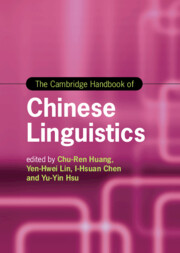Book contents
- The Cambridge Handbook of Chinese Linguistics
- Cambridge Handbooks In Language and Linguistics
- The Cambridge Handbook of Chinese Linguistics
- Copyright page
- Contents
- Figures
- Tables
- Contributors
- Acknowledgments
- Part One Writing System/Neuro-cognitive Processing of Chinese
- Part Two Morpho-lexical Issues in Chinese
- Part Three Phonetic-phonological Issues in Chinese
- Part Four Syntax-semantics, Pragmatics, and Discourse Issues
- 19 SVO as the Canonical Word Order in Modern Chinese
- 20 SOV as the Canonical Word Order in Modern Chinese
- 21 Semantic and Pragmatic Conditions on Word Order Variation in Chinese
- 22 The Case for Case in Chinese
- 23 The Case without Case in Chinese
- 24 The Syntax of Classifiers in Mandarin Chinese
- 25 The Chinese Classifier System as a Lexical-semantic System
- 26 Syntax of Sentence-final Particles in Chinese
- 27 Sentence-final Particles
- 28 Topicalization Defined by Syntax
- 29 An Interactive Perspective on Topic Constructions in Mandarin
- 30 Grammatical Acceptability in Mandarin Chinese
- Index
- References
26 - Syntax of Sentence-final Particles in Chinese
from Part Four - Syntax-semantics, Pragmatics, and Discourse Issues
Published online by Cambridge University Press: 04 August 2022
- The Cambridge Handbook of Chinese Linguistics
- Cambridge Handbooks In Language and Linguistics
- The Cambridge Handbook of Chinese Linguistics
- Copyright page
- Contents
- Figures
- Tables
- Contributors
- Acknowledgments
- Part One Writing System/Neuro-cognitive Processing of Chinese
- Part Two Morpho-lexical Issues in Chinese
- Part Three Phonetic-phonological Issues in Chinese
- Part Four Syntax-semantics, Pragmatics, and Discourse Issues
- 19 SVO as the Canonical Word Order in Modern Chinese
- 20 SOV as the Canonical Word Order in Modern Chinese
- 21 Semantic and Pragmatic Conditions on Word Order Variation in Chinese
- 22 The Case for Case in Chinese
- 23 The Case without Case in Chinese
- 24 The Syntax of Classifiers in Mandarin Chinese
- 25 The Chinese Classifier System as a Lexical-semantic System
- 26 Syntax of Sentence-final Particles in Chinese
- 27 Sentence-final Particles
- 28 Topicalization Defined by Syntax
- 29 An Interactive Perspective on Topic Constructions in Mandarin
- 30 Grammatical Acceptability in Mandarin Chinese
- Index
- References
Summary
Sentence-final particles are normally assumed to occur in the CP domain, i.e., the domain of the complementizer phrase. Their exact syntactic position varies given the heterogeneity of these elements. The position of these particles usually depends on how they are categorized semantically, and also on how they conform to different syntactic principles. Several distinctive and often competing approaches are addressed here. This chapter also discusses those 'sentence-final particles' that are found in the lower domains and revisits the question of whether some, if not all, elements that are said to belong to the category of sentence-final particles should be construed as non-CP elements.
Keywords
- Type
- Chapter
- Information
- The Cambridge Handbook of Chinese Linguistics , pp. 578 - 596Publisher: Cambridge University PressPrint publication year: 2022
References
- 1
- Cited by



